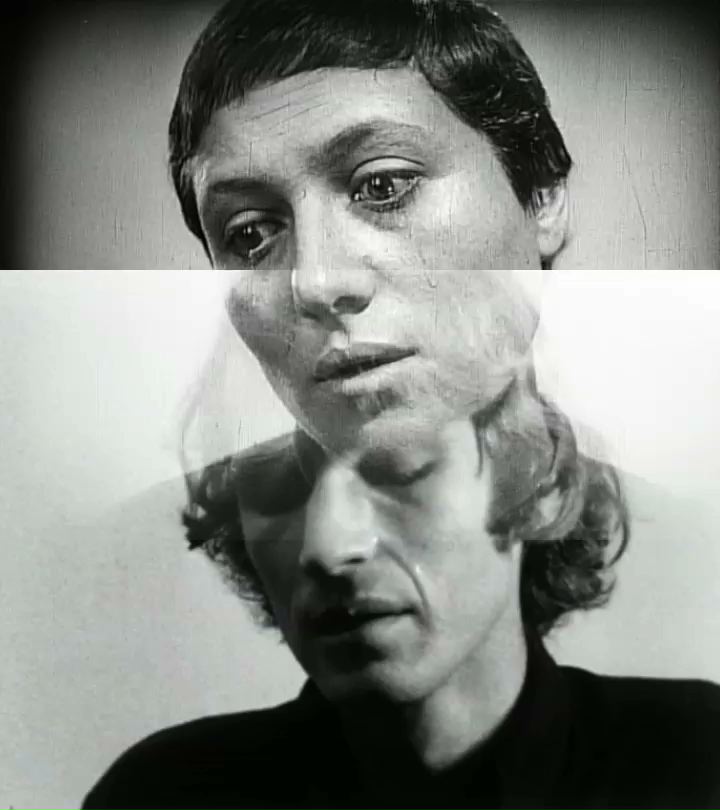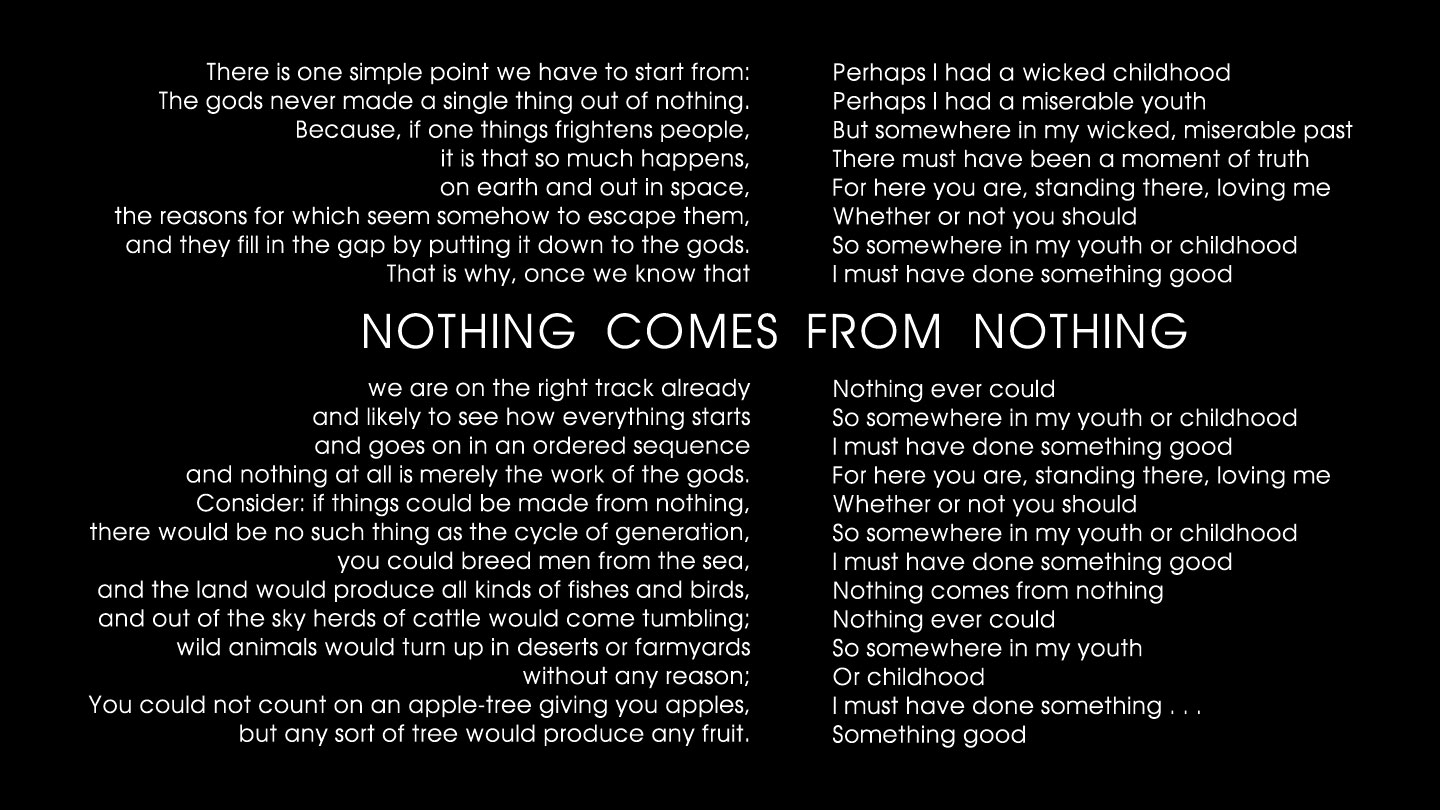On the (im)possibility of a pure praise poem
British Council & Man&Eve, London →
21 Jun – 27 Jul 2013
Aliki Braine, Mark Dean, Dom Sylvester Houédard, Anna Sikorska
bibliography:
Phil Baines, ‘On the (im)possibility of a pure praise poem’, Art & Christianity, No 75, Autumn 2013
Lucy Newman Cleeve, On the (im)possibility of a pure praise poem, catalogue essay, 2013
exhibited works:
Ascension (nothing/Something Good)
Nothing Comes From Nothing (Lucretius, Rodgers & Hammerstein)
gallery information:
“Poetry all art is one of universal worships a l’insu of god the unknown.”
– Dom Sylvester Houédard
In an interview with Ian MacMillan in 2006, the poet Geoffrey Hill spoke about “the impossibility of a pure praise poem”. Hill’s bold assertion forms the basis of enquiry for this exhibition, which brings together work by the late Benedictine priest, theologian and Concrete poet Dom Sylvester Houédard (aka dsh), with work by three contemporary artists: Aliki Braine, Mark Dean and Anna Sikorska. The exhibition explores, in various media, whether the creative act and its product can ever comprise ‘pure praise’, or whether the incidence of a ‘pure praise poem’ (or equally of a pure praise photograph, painting, video or sculpture) is unattainable.
A number of intriguing symmetries occur within the exhibition, not least the fact that it includes work made by two ordained priests (dsh and Dean). dsh understood his visual poems and ‘typestracts’ as “icons depicting sacred questions,” and Dean’s video works, which have been described by David Curtis as “votive offerings,” also function in the interrogative mode. In each case, there is a tacit acceptance that answers will not be forthcoming. For dsh, questions are met with mysteries, “to which the appropriate response can never be an ‘answer’ but has to be a growth of awareness and awe – gratitude, depth and pleasure.” This attitude of praise defines the creative act, but cannot necessarily be conveyed to the viewer who joins with the artist in constructing the meaning of the work.
Dean’s work relies heavily upon the appropriation of, often iconic, film and video footage and music. It introduces visual and aural puns that behave as the generators and interrogators of meaning within the work, setting up a series of disputations between the different elements being sampled. Although the work is always carefully constructed, the reverberations and analogies created by placing potent symbols side by side are myriad. The screen becomes a crucible in which layers of meaning are compounded, burnt and refined.’
‘On the (im)possibility of a Pure Praise Poem’, Phil Baines, Art and Christianity 75, Autumn 2013
I first came across the work of the Dominican monk, concrete poet and scholar Dom Sylvester Houédard in the compendium Art without boundaries (Woods G, Thomson P & Williams J, Thames & Hudson 1972).
The book in general, and the concrete poetry of Houédard in particular, formed an alternative set of references for several of us studying graphics at art school in the early 1980’s. His work has attracted growing interest since his death in 1992 and a monograph – ‘Notes from the cosmic typewriter’ (ed. Simpson N) – was published last year by Occasional Papers. This exhibition showed work by Houédard, Mark Dean (an Anglican priest), and the younger artists Aliki Braine and Anna Sikorska and explored the theme of the title.*
Houédard’s work was grouped in two areas, with more abstracted wall pieces on the ground floor, and books and more poetic work downstairs. On entering the gallery the large and colourful ‘Memorial to Ken Kox’ was an obvious presence, but it was the smaller ‘typestracts’ which caught my attention. Rarely larger than a quarto sheet (10” x 8”) these pieces were delicate constructions created with a typewriter and sometimes carbon paper. While a few dealt with fragments of text, most used letters, punctuation or symbols a painter might use a brush stroke. Despite their small scale, I found them immersive as Rothko’s ‘Seagram’ series at the Tate, which accords with an assertion by him in Art without boundaries: ‘I see my typestracts as icons depicting sacred questions’ (p.136).
Dean’s ‘Nothing Compares 2 U’ worked on several levels depending on how well you knew your art and film history or had read the excellent exhibition notes by Lucy Newman Cleeve. A film in portrait format comprising two overlapped sequences, one of a man, the other of a shaven headed woman (from a previous, possibly silent era judging from the film stock), both crying uncontrollably. The soundtrack a haunting 80’s sounding synth pop song layered and looped, melancholic, but not quite at one with the film. I found the work incredibly moving without knowing the references: a pairing of Maria Falconetti in the film ‘La passion de Jeanne d’Arc’ (1928), with part of ‘I’m too sad to tell you’ (1970) by Bas Jan Ader, to the soundtrack of a remixed version of the Mirrors’ cover (2011) of Dino Valenti’s ‘Something’s on your mind’ (Karen Dalton, 1971). These aspects of layering, not immediately obvious – and arguably not strictly necessary to its appreciation – added weight to the work and suggest an interest in the materiality of process which was common to all four artists. For Houédard the typewriter was pushed to the limits: letters were used as marks; conventions of line spacing were ignored; the sheet was worked, then taken out and re-worked, sometimes several times; if a coloured ribbon couldn’t be found, carbon paper was used.
In Braine’s work – aptly described as ‘concrete photography’ – the substance of analogue photographic film is clearly evident. With no image exposed, the print reveals the substance of the film itself, slightly scratched and real, interrupted by either punched holes or applied stickers.
Sikorska’s interest in material is slightly different and perhaps more open to ambiguity than the others. The works ‘Colosseum’ and ‘St Andrew unadorned’ play with the visual similarities between title and object, but material differences: between the titled object and the art object, and between the art object and that object’s original material. Here a knowledge of the title is critical to unlocking the work, and the sense of materiality, and her play with it, was less immediately obvious.
Man&Eve must be congratulated on bringing this body of work together. The exhibition title can be taken two ways. I’m sure for many the work provided a vibrant affirmation that a pure praise poem is indeed possible, for others it opened their eyes to at least the possibility.
Phil Baines is a Graphic designer and Professor of Typography at Central St Martins, University of the Arts London.



